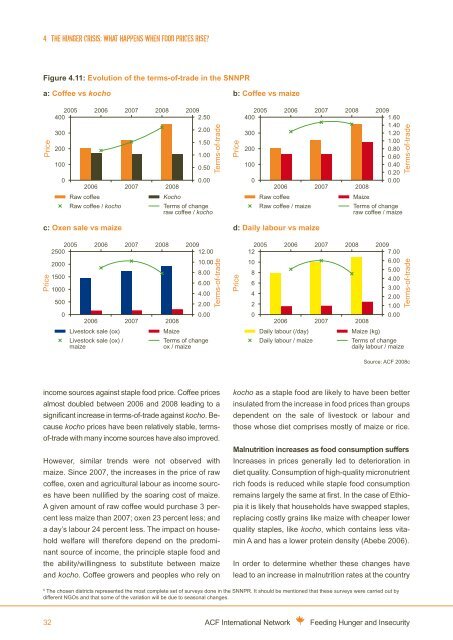Feeding hunger and insecurity
Feeding hunger and insecurity
Feeding hunger and insecurity
- No tags were found...
Create successful ePaper yourself
Turn your PDF publications into a flip-book with our unique Google optimized e-Paper software.
4. the <strong>hunger</strong> crisis: what happens when food prices rise?Figure 4.11: Evolution of the terms-of-trade in the SNNPRa: Coffee vs kochob: Coffee vs maizePrice2005 2006 2007 2008 20094002.5030020010002006 2007 2008Raw coffeeRaw coffee / kochoKocho2.001.501.000.500.00Terms of changeraw coffee / kochoTerms-of-tradePrice2005 2006 2007 2008 20094001.601.403001.201.002000.800.601000.400.2000.002006 2007 2008Raw coffeeRaw coffee / maizeMaizeTerms of changeraw coffee / maizeTerms-of-tradec: Oxen sale vs maized: Daily labour vs maizePrice2005 2006 2007 2008 2009250012.002000 10.001500100050002006 2007 2008Livestock sale (ox)Livestock sale (ox) /maizeMaize8.006.004.002.000.00Terms of changeox / maizeTerms-of-tradePrice2005 2006 2007 2008 2009127.0010864202006 2007 2008Daily labour (/day)Daily labour / maizeMaize (kg)6.005.004.003.002.001.000.00Terms of changedaily labour / maizeTerms-of-tradeSource: ACF 2008cincome sources against staple food price. Coffee pricesalmost doubled between 2006 <strong>and</strong> 2008 leading to asignificant increase in terms-of-trade against kocho. Becausekocho prices have been relatively stable, termsof-tradewith many income sources have also improved.However, similar trends were not observed withmaize. Since 2007, the increases in the price of rawcoffee, oxen <strong>and</strong> agricultural labour as income sourceshave been nullified by the soaring cost of maize.A given amount of raw coffee would purchase 3 percentless maize than 2007; oxen 23 percent less; <strong>and</strong>a day’s labour 24 percent less. The impact on householdwelfare will therefore depend on the predominantsource of income, the principle staple food <strong>and</strong>the ability/willingness to substitute between maize<strong>and</strong> kocho. Coffee growers <strong>and</strong> peoples who rely onkocho as a staple food are likely to have been betterinsulated from the increase in food prices than groupsdependent on the sale of livestock or labour <strong>and</strong>those whose diet comprises mostly of maize or rice.Malnutrition increases as food consumption suffersIncreases in prices generally led to deterioration indiet quality. Consumption of high-quality micronutrientrich foods is reduced while staple food consumptionremains largely the same at first. In the case of Ethiopiait is likely that households have swapped staples,replacing costly grains like maize with cheaper lowerquality staples, like kocho, which contains less vitaminA <strong>and</strong> has a lower protein density (Abebe 2006).In order to determine whether these changes havelead to an increase in malnutrition rates at the country6The chosen districts represented the most complete set of surveys done in the SNNPR. It should be mentioned that these surveys were carried out bydifferent NGOs <strong>and</strong> that some of the variation will be due to seasonal changes.32ACF International Network<strong>Feeding</strong> Hunger <strong>and</strong> Insecurity

















